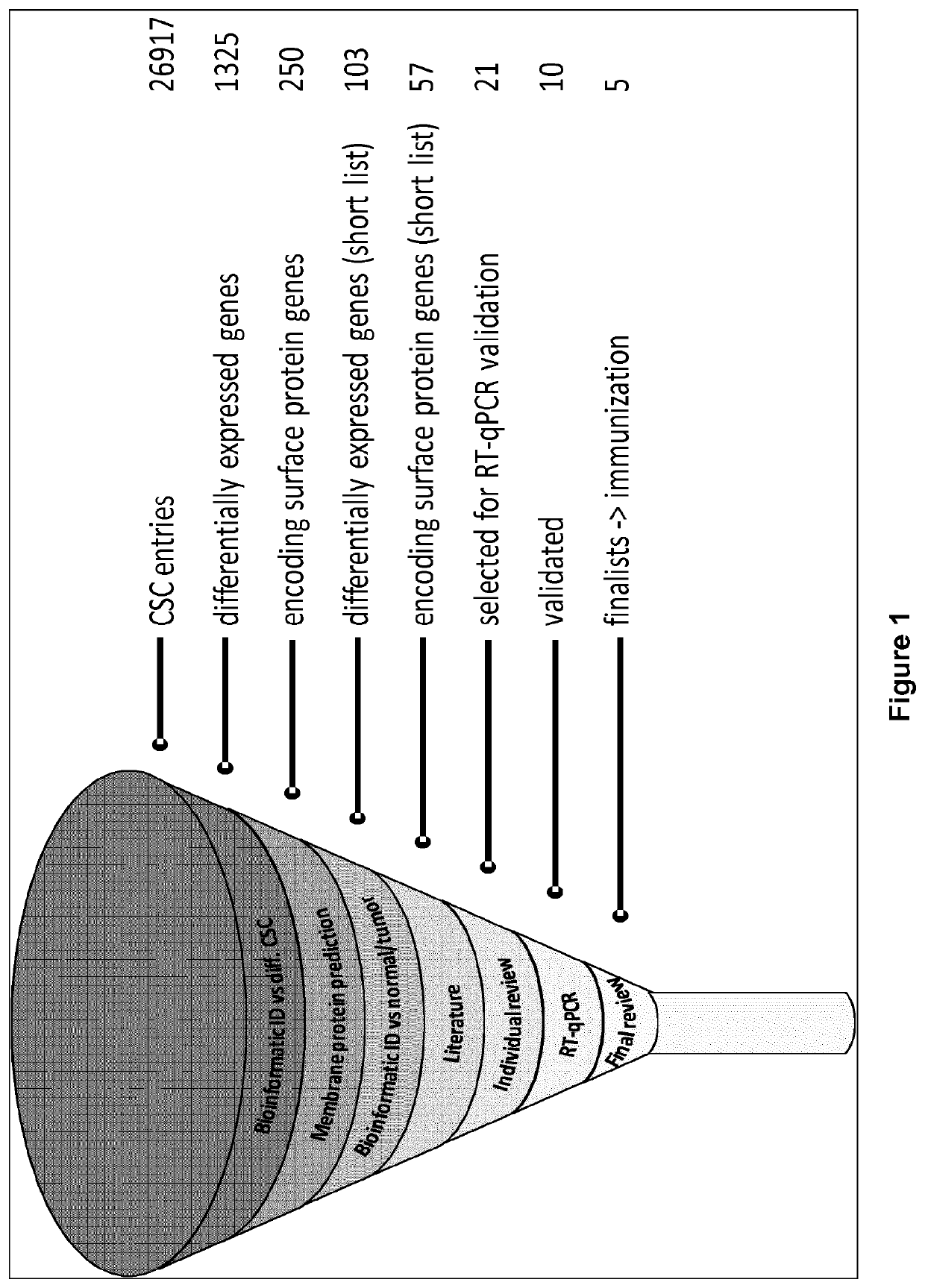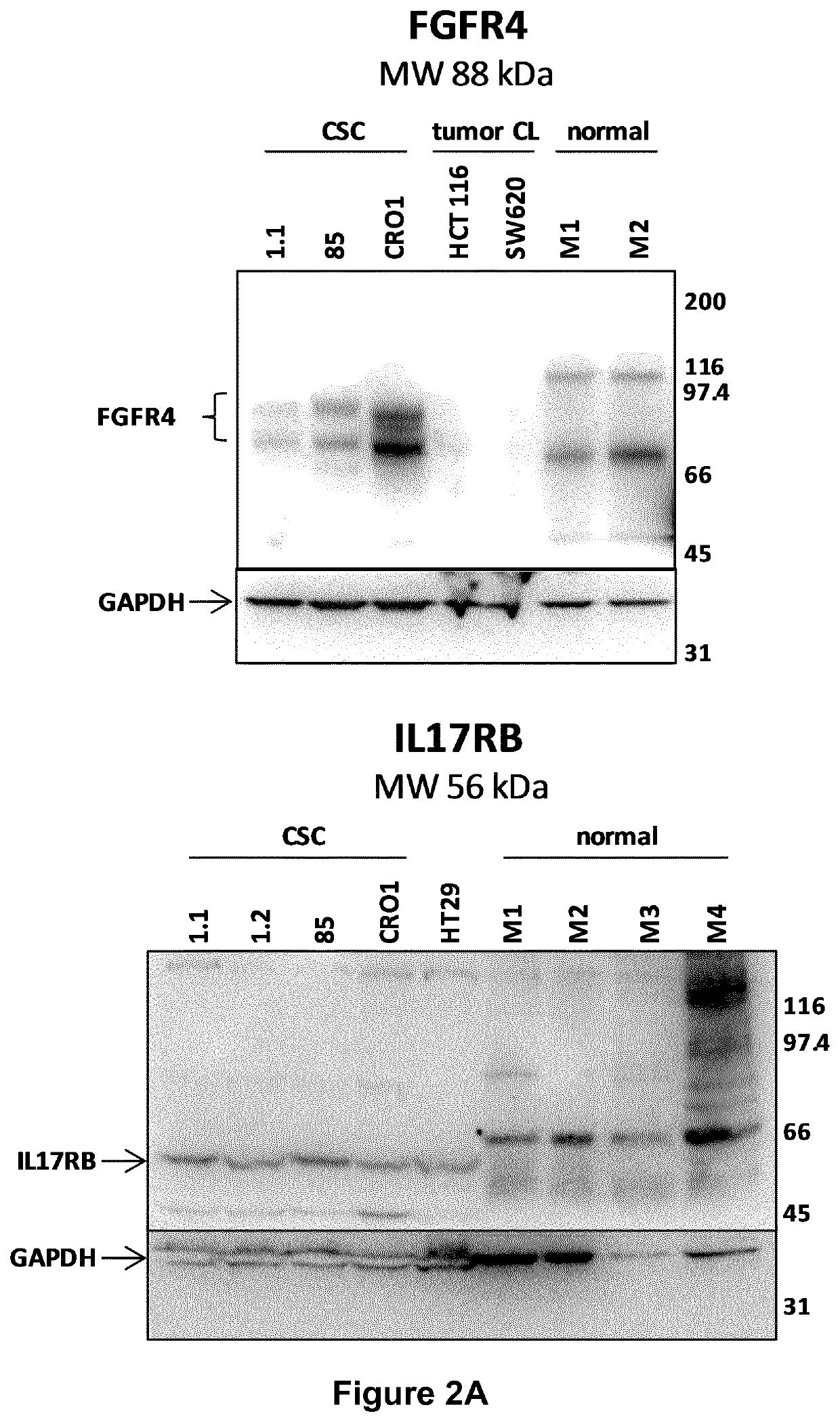Monoclonal antibody Anti-fgfr4
a monoclonal antibody and anti-fgfr4 technology, applied in the field of monoclonal antibody anti-fgfr4, can solve the problems of colorectal cancer (crc) being a major cause of morbidity and mortality in the world, affecting the quality of life of people, and presenting a mounting socio-economic burden worldwide, so as to efficiently inhibit the binding of fgf ligands and improve the signalling of ligand-dependen
- Summary
- Abstract
- Description
- Claims
- Application Information
AI Technical Summary
Benefits of technology
Problems solved by technology
Method used
Image
Examples
example 1
Bioinformatic Identification of Genes Encoding Membrane Proteins Selectively Expressed in Colon Cancer Stem Cells
[0300]In order to identify novel colon cancer stem cells (CSC) membrane antigens, a computational analysis has been performed by mining a proprietary CSC-specific Affymetrix microarray and cross-querying available public expression databases.
[0301]This analysis took advantage of the availability of a genome-wide gene expression data bank (Affymetrix microarray, Human Gene 1.0 ST platform), including data obtained from eight colon CSC lines isolated from primary tumor samples and metastases that were propagated as spheroids in defined serum-free media complemented with EGF and bFGF, or differentiated in vitro in the presence of 10% serum (Ricci-Vitiani et al., 2007). This dataset contains distinct probesets for 26917 different human genes.
[0302]In order to define a list of potential target genes the following overall workflow was adopted. Using the reference colon CSC data...
example 2
Confirmation of the Specificity of the Selected Gene Expression in Colon CSC
[0311]The differential expression of the 21 selected genes have been confirmed and quantified by qRT-PCR. The eight different colon CSC lines used to generate microarray data were propagated as spheroids in defined serum-free media complemented with EGF and bFGF. For comparison, eleven different commercial colon tumor cell lines (ATCC), selected among those included in the dataset used in the bioinformatic analysis, were cultured following ATCC recommendations (Table 5).
TABLE 5Colon tumor cell lines analyzed by qRT-PCR.Colon CSC line Colon tumor cell line Code1.1 Caco-2 cl11.2 DLD-1 cl218 HCT 1 16 cl385 HCT 15 cl4CR01 HT-29 cl5CC1 LoVo cl6CC2 SNU-C2B cl7CC5 SW48 cl8SW480 cl9SW620 cl10WiDr cl1 1
[0312]Total RNA was prepared using the RNAeasy mini kit (Qiagen) following the manufacturer's recommendations. RNA samples were collected in RNase-free water, quantified by measuring the absorbance at 260 nm using an E...
example 3
Generation of Monoclonal Antibodies Against the Colon CSC Membrane Antigens
[0318]Monoclonal antibodies (mAbs) against the five selected antigens have been generated by genetic immunizations of rats using the Aldevron / GENOVAC core technology platform that enables the development of antibodies against protein targets directly using the corresponding DNA coding-sequences (http: / / www.aldevron.com / services / antibody-development / genetic-immunization, see for example the following references:
[0319]Bioprocessing—Genetic Immunization for Antibody Production. Tutorial: Genovac's Technological Shortcut From Gene to Antibody. By John Thompson, Ph.D., and Stefan Lang, Ph.D., published in Genetic Engineering News, Vol. 22, No. 17, Oct. 1, 2002; Custom-made antibodies produced by genetic immunisation: Applications in drug development, therapy and diagnosis. By Stefan Lang and John Thompson, published in Global Outsourcing Review, Vol. 5, No. 1, Spring 2003; A shortcut from genomics to drug developm...
PUM
| Property | Measurement | Unit |
|---|---|---|
| Fraction | aaaaa | aaaaa |
| Fraction | aaaaa | aaaaa |
| Volume | aaaaa | aaaaa |
Abstract
Description
Claims
Application Information
 Login to View More
Login to View More - R&D
- Intellectual Property
- Life Sciences
- Materials
- Tech Scout
- Unparalleled Data Quality
- Higher Quality Content
- 60% Fewer Hallucinations
Browse by: Latest US Patents, China's latest patents, Technical Efficacy Thesaurus, Application Domain, Technology Topic, Popular Technical Reports.
© 2025 PatSnap. All rights reserved.Legal|Privacy policy|Modern Slavery Act Transparency Statement|Sitemap|About US| Contact US: help@patsnap.com



